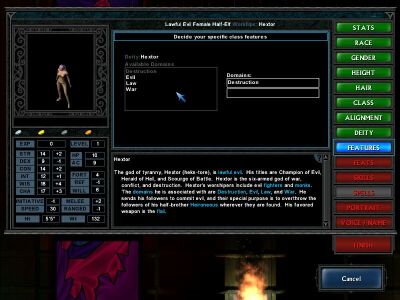 Information Information |
|
All pages on this site are
(c) 2002, 2003, Michael Wolf. All rights reserved.
Contact
stargazer@rpgplanet.com
ICQ# 132739060

Hosted by RPGPlanet
|
|
 A
deeper look at ToEE's character creation A
deeper look at ToEE's character creation |
|
In
the last feature about the character creation in Troika's Temple
of Elemental Evil we presented a step-by-step demonstration
of the character creation process. This time we'll have a deeper
look at the details that could be seen in the screenshots released
by Atari.
The roll method and the assignment of
ability scores
We already had a look at the point-buy-system, so this time
we concentrate on the roll method. The standard method in D&D
is to roll 4D& (D6 = six-sided die), drop the lowest score and
sum up the rest.

If you for example roll 4, 3, 5 and 1, you can drop 1 and 4
+ 3 + 5 equals 12. You do this six times to generate the attribute
values (in ToEE all values are generated by the computer at
once, of course). As you can see in this screenshot the player
can assign the values as he sees fit. This is done by drag-and-drop.

The game also counts how many times you have rolled. In pen
& paper roleplaying you have ask the Dungeon Master for permission
to reroll you stats, but ToEE like most CRPGs allows you to
reroll as often as you wish. Additionally, scores with abilty
bonusses that total less than 0 or scores with no number greater
than 13 are rerolled automatically.
This method ensures above average ability scores for your character.
If you are still unhappy but don't want to reroll hundreds of
times, don't despair! D&D 3.5 edition allows you to improve
one ability score by one point every four character levels.
This may not look much, but sometimes it can make the difference.
And remember that D&D characters are not determined by the ability
scores alone!
Clerics, Deities and their Domains
Clerics have to choose one of the 19 gods available in ToEE.
Of course other characters choose their patron deities too,
but it has special significance for clerics. You can only choose
deities with an aligment not more than one step away. So a lawful
good cleric cannot choose an lawful evil god as patron.

In the lower half of the screen you get some information about
the deity you chose. In this case Hextor was chosen. This lawful
evil deity is associated with the domains of Destruction, Evil,
Law and War. He wages war against his half-brother Heironeous
and his favorite weapon is the flail. Clerics are allowed to
choose two of their deities domains during the next step. They
also get the proficiency to wield their deity's favorite weapon
for free if they haven chosen the war domain!

Note that clerics have access to all cleric spells if they meet the level requirements, so you don't have to choose spells at the beginning of the game.
This concludes our in-depth look of the cleric.
Continue
|
|
News
|
 Feature Feature |
|
"A
deeper look at ToEE's character creation" by Michael Wolf
|
 Google
Search Google
Search |
|
 Quicklinks Quicklinks |
- Official ToEE site (Link)
- Troika Games (Link)
-
-
Wizards of the Coast (Link)
- Greyhawk Inn forum (Link)
- Greyhawk Chronicles
forums (Link)
- IBNobody's ÜberFAQ (Link)
|
 Counter Counter |

|
|




